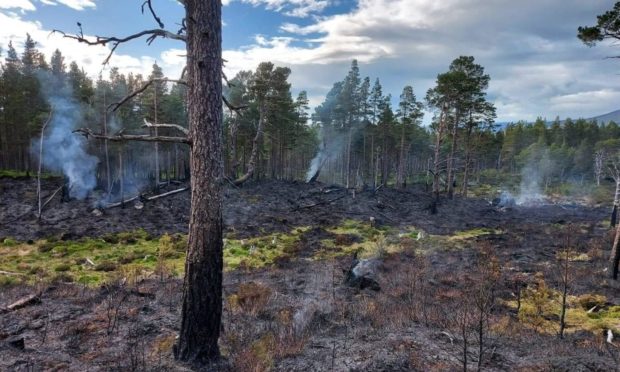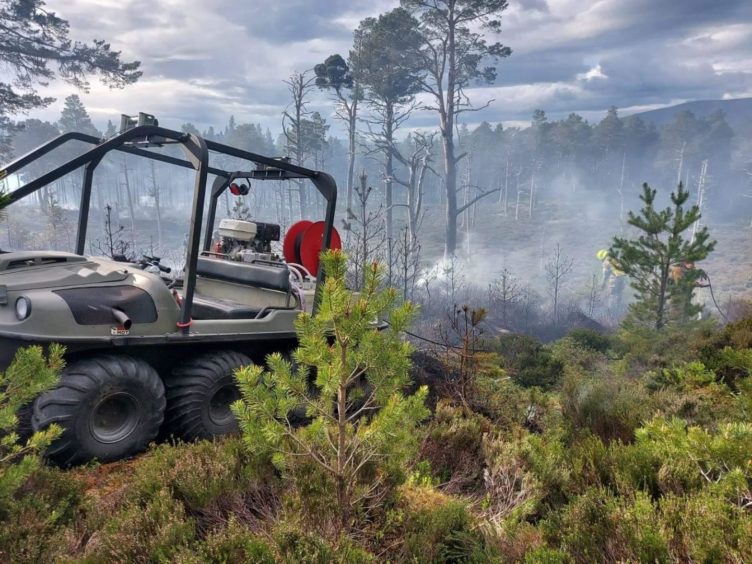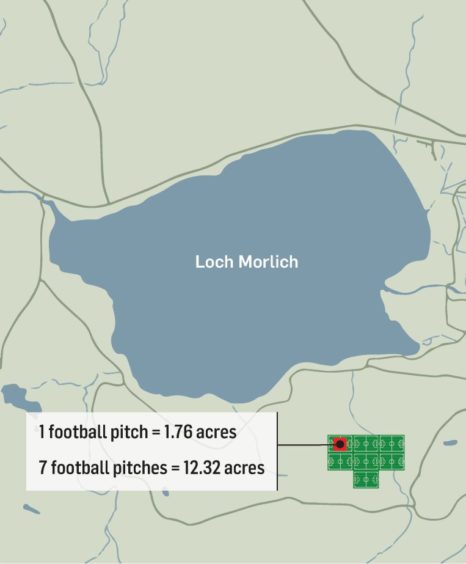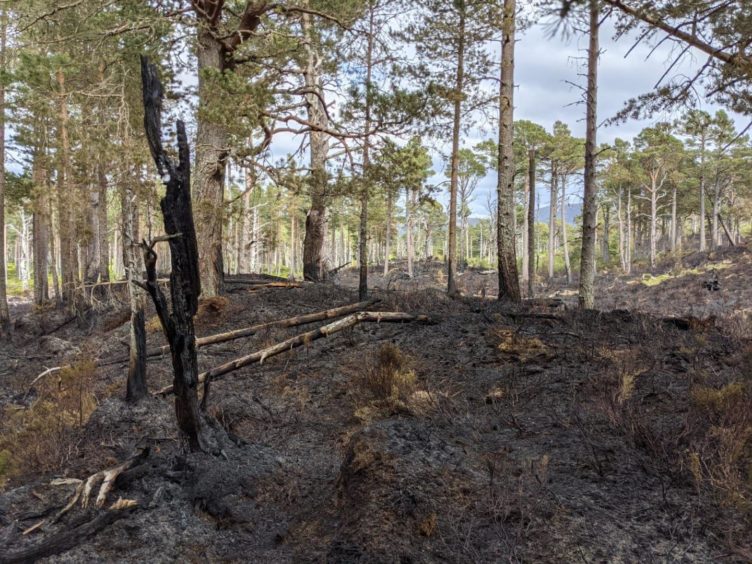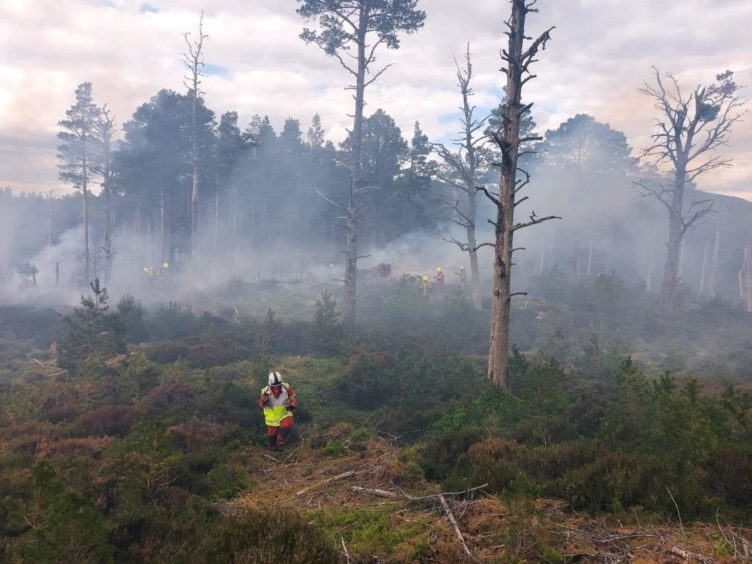Around seven football pitches worth of forest was burned in a severe wildfire in the heart of the Cairngorms National Park over the weekend – prompting warnings for visitors over the coming days.
Over Saturday June 5 and Sunday June 6, a huge area of woodland near Loch Morlich, close to Aviemore, was damaged by what Forestry and Land Scotland (FLS) called a “devastating but preventable” fire.
The fire service attended the blaze from Saturday afternoon until the following morning when the situation was declared safe, and the cause remains unknown.
And with warm conditions forecast to continue across the Cairngorms this weekend, visitors to the national park and other beauty spots across Scotland have been urged to think twice before lighting up a campfire or barbecue.
Fire’s impact can last “Months, years, or even decades”
Maree Morison, recreation ranger for FLS said: “A huge thanks to the crews from Scottish Fire and Rescue Service who attended on the day and stopped this fire from being much worse.
“Over recent weeks we have been working closely with the Cairngorms National Park Authority (CNPA) and SFRS to raise awareness of the ‘very high fire risk’ message by using social media, on-site signage and leaflets, all supplemented by additional on-site staff who are helping us to convey this and other key messages.
“The impact of wildfires can affect habitats and wildlife for months, years or even decades.
“It is imperative that visitors plan ahead and are aware of the potential safety precautions that they need to take, especially when conditions are so hot and dry.”
Campfires
Although the traditional picturesque image of camping around a roaring fire may seem appealing, the realities of a campfire can be much more dangerous.
Even when surrounded by stones, in certain kinds of environment fires can ignite the ground beneath, and disposable barbecues can cause all sorts of problems.
Adam Streeter-Smith, outdoor access officer for the CNPA, said personal responsibility is key when igniting any sort of fire in the Cairngorms or elsewhere in Scotland.
He said: “Ultimately, the Land Reform (Scotland) Act and the Scottish Outdoor Access Code tell the public what they can and can’t do in Scotland in terms of exercising their access rights, and within the national park, the CNPA is the access authority, and it provides advice and guidance to the public to help them enjoy the park responsibly.
“The Code says in terms of campfires, never light one during periods of high fire risk, never on peatlands, in woodlands or near woodlands, and on farmland.
“So within the national park it’s really hard to have a fire responsibly, because the bulk of the park is either peatland, woodland or farmland.
“And we are going through a period of high fire risk at present, so even if people were to find a location where it would be responsible to have a fire, it wouldn’t be responsible because we’re still experiencing lengthy periods of dry weather with high fire risks in place.
“We’re asking everyone to do their bit to preserve these woodlands and peatlands for future generations, by choosing not to have a campfire, and use a stove instead.
“They’re clean, the risk of causing a fire is low, they won’t damage the ground beneath them, and once you’re gone nobody will know you’ve been there.”
Cooking and barbeques
Mr Streeter-Smith continued: “People need to cook if they’re camping, so of course they can use a stove, but what we’d say about barbecues is it’s very difficult to have a barbecue responsibly, particularly with the disposable barbecues that can leave quite a scar on the ground and are difficult to dispose of after you’ve cooked on it.
“They tend to lead to litter problems where they’re being left around, and even when people think they’re doing the right thing and disposing of them, they can remain quite hot, and we’ve had quite a number of bin fires in the national park as a result.
“During periods of high fire risk, don’t have barbecues or campfires, and if you need to cook, use a stove.
“And when there isn’t a period of high fire risk, if you’re going to use a barbecue, we’d always say they’re best at home but if you must, do it responsibly, and in the right location.
“Some areas of the park have facilities for them, like picnic benches with heatproof mats, and if there’s not one of those have it on stone, sand or shingle.”
Damage to wider environment and rare species
As well as the potential for causing wildfires, irresponsible campfires can have a wider impact on some of Scotland’s most precious species and environments.
Mr Streeter-Smith added: “People might think they’re doing the right thing by having a fire with a ring of stones around it, but if that fire is on peat, it’s going to burn down as well as up.
“So people might think the fires out, but it will actually still be smouldering away in the peat underneath the fire.
“And of course the firewood people might think they can collect for a campfire might actually be valuable habitat for rare invertebrates and insects, so it’s crucial that we do what we can to protect and conserve the national park for future generations.
“Stick to stoves. That’s the best thing.
“In this day and age, we’re all very keen to make sure we tread lightly on the planet, leave no trace and do the right thing.”
In August 2020, Cairngorms rangers had to tackle 143 fires across the national park.
